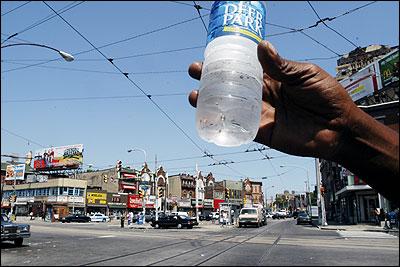Read the book, watch the movie
 Photo: TOM GRALISH / Philadelphia Inquirer. Penn professor Elijah Anderson describes this part of Germantown Avenue, where public transit and retailing join, as a “hyperghetto.”
Photo: TOM GRALISH / Philadelphia Inquirer. Penn professor Elijah Anderson describes this part of Germantown Avenue, where public transit and retailing join, as a “hyperghetto.”I write a lot on e-lists and in the blog, about the work of Professor Elijah Anderson of the University of Pennsylvania, and his books Code of the Street: Decency, Violence and the Moral Life of the Inner City and Streetwise. This article from the Philly Inquirer, "Germantown Ave. from top to bottom: Video documentary shows a street of extremes," alerts us to a video made by students from Rutgers University at Camden, to illustrate the book's introduction--which is a tour of the length of Germantown Avenue, starting in the tony neighborhood of Chestnut Hill on the border of Philadelphia and the adjoining county and ending up in the heart of inner city Philadelphia.
Code of the Street is on the reading list for courses at 270 colleges across the country. (Clearly people not familiar with cities need some sort of visual presentation to understand this kind of progression.)
According to the article:
The documentary, based on Anderson's introduction, was produced this spring to assist readers of the book. The video "kind of gives you a different perspective on how the city can go from one extreme, from wealth and poverty in just five miles," said Jackson, who helped shoot the video. The video begins in Chestnut Hill, which Wood noted is often called "the suburb in the city," and ends in the Northern Liberties section. Along the way, Flatley and Wood describe the decline in the appearance of the stores, homes and factories, many of them dilapidated and abandoned.
They note that the village-like shopping district of Chestnut Hill gradually gives way to stores outfitted with burglar bars and riot gates as you move past Mount Airy and into Germantown and North Philadelphia. The premise of Anderson's book is that in communities where factories and other large employers have moved out and poverty has taken hold, a street culture develops that is characterized by a lack of faith in police protection and civil law.
As a result, Anderson writes, a code of the streets emerges, "a set of informal rules governing interpersonal public behavior, particularly violence. The rules prescribe both proper comportment and the proper way to respond if challenged, often with violence." In an interview on Germantown Avenue in Chestnut Hill, Anderson said: "This street is historic. It's hard to believe it's the same street down the way.
"We are talking about poverty that can't be laid at the feet of the people. The jobs are not here. When one is unable to find decent work there are negative consequences for communities." Anderson said the problems on Germantown Avenue are mirrored in many U.S. cities. The book, he said, has implications for understanding distressed communities around the country. Wood said that even in areas where the "code of the street" dominates, "there are pockets of resistance and renewal as well."
_____
The video is online here. The Inquirer article includes a link to a Flash photo slideshow with 29 photos at various points along Germantown Avenue.



0 Comments:
Post a Comment
<< Home